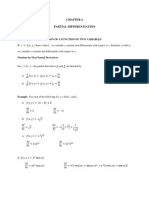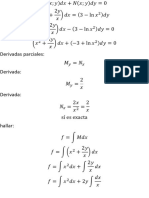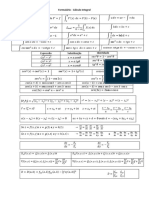integrating factor
Uploaded by
sma08ssintegrating factor
Uploaded by
sma08ssSTEP EXAMPLE
1. Arrange to the form 𝑑𝑦
𝑑𝑦 𝑥 + 𝑦 = 𝑥2
𝑑𝑥
+ 𝑷(𝒙)𝑦 = 𝑸(𝒙)
𝑑𝑥 𝑑𝑦 𝑦
+ =𝑥
𝑑𝑥 𝑥
2. 𝑃(𝑥) =? 𝑄(𝑥) =? 𝑑𝑦 𝟏
+ 𝑦=𝒙
𝑑𝑥 𝒙
𝟏
𝑷(𝒙) = 𝑸(𝒙) = 𝒙
𝒙
1
3. Integrating Factor:
𝒗(𝒙) = 𝑒 ∫𝑥𝑑𝑥
𝒗(𝒙) = 𝑒 ∫ 𝑃(𝑥)𝑑𝑥
𝒗(𝒙) = 𝑒 ln 𝑥
𝒗(𝒙) = 𝒙
4. Multiply 𝒗(𝒙) to 𝑑𝑦 𝑦
𝑑𝑦 𝒙 + 𝒙 ( ) = 𝒙(𝑥)
𝑑𝑥 𝑥
+ 𝑷(𝒙)𝑦 = 𝑸(𝒙)
𝑑𝑥 𝑑𝑦
𝑥 + 𝑦 = 𝑥2
𝑑𝑥
5. Change to the form 𝑑
𝑑 (𝒙𝑦) = 𝑥 2
(𝒗(𝒙)𝑦) = 𝑸(𝒙)𝒗(𝒙) 𝑑𝑥
𝑑𝑥
6. Integrate both side 𝑑
∫ (𝒙𝑦) 𝑑𝑥 = ∫ 𝑥 2 𝑑𝑥
𝑑𝑥
𝒙𝑦 = ∫ 𝑥 2 𝑑𝑥
𝑥3
𝒙𝑦 = +𝐶
3
7. Substitute initial condition (if Example : 𝑦 = 0 , 𝑥 = 3
given) to find value of
(3)3
arbitrary constant (3)(0) = +𝐶
3
𝐶 = −9
𝑥3
𝑥𝑦 = −9
3
𝑥2 9
𝑦= −
3 𝑥
You might also like
- Engineering Analysis: Faculty of Engineering Petroleum EngineeringNo ratings yetEngineering Analysis: Faculty of Engineering Petroleum Engineering8 pages
- Presentador: M. en C. José Manuel Rosales Guzmán 13/07/2021No ratings yetPresentador: M. en C. José Manuel Rosales Guzmán 13/07/20211 page
- Newton-Leibnitz Rule & Standard IntegralsNo ratings yetNewton-Leibnitz Rule & Standard Integrals4 pages
- Derivada de una funcion. I Parte_9201ace7917d5070c682901e68422238No ratings yetDerivada de una funcion. I Parte_9201ace7917d5070c682901e684222386 pages
- Differential Equation - Examples of Integrating FactorsNo ratings yetDifferential Equation - Examples of Integrating Factors4 pages
- Pure Mathematics: Revision Worksheet - 2No ratings yetPure Mathematics: Revision Worksheet - 214 pages
- Lecture-014 Divergence Theorem Class Lecture StudentNo ratings yetLecture-014 Divergence Theorem Class Lecture Student12 pages
- Araneta All Problem Sets Exams Practice Exams Math 83No ratings yetAraneta All Problem Sets Exams Practice Exams Math 8355 pages
- D091201056 - Akbar Suparman Panggalo - TugasMatekNo ratings yetD091201056 - Akbar Suparman Panggalo - TugasMatek9 pages
- Evaluación Continua Virtual 1 Ejercicios Ecuaciones Diferenciales ExactasNo ratings yetEvaluación Continua Virtual 1 Ejercicios Ecuaciones Diferenciales Exactas3 pages
- Application of Partial Differential EquationsNo ratings yetApplication of Partial Differential Equations7 pages
- De Moiver's Theorem (Trigonometry) Mathematics Question BankFrom EverandDe Moiver's Theorem (Trigonometry) Mathematics Question BankNo ratings yet
- Trigonometric Ratios to Transformations (Trigonometry) Mathematics E-Book For Public ExamsFrom EverandTrigonometric Ratios to Transformations (Trigonometry) Mathematics E-Book For Public Exams5/5 (1)
- Medical Center Map - Directions - Hotel Information PDFNo ratings yetMedical Center Map - Directions - Hotel Information PDF3 pages
- On The Method of Ship's Transoceanic Route PlanningNo ratings yetOn The Method of Ship's Transoceanic Route Planning8 pages
- Department of Education: Philippine Contemporary Arts in The Region Quarter3-Week3-4No ratings yetDepartment of Education: Philippine Contemporary Arts in The Region Quarter3-Week3-46 pages
- PCS 7 APACS OS Symbols and Faceplates V6.1No ratings yetPCS 7 APACS OS Symbols and Faceplates V6.166 pages
- FRLO 14410C T2 Fuller 10 Speed Parts Breakdown ManualNo ratings yetFRLO 14410C T2 Fuller 10 Speed Parts Breakdown Manual27 pages
- CFD Modeling and Approaches For Calculating The Losses of A Subsea Pipeline Transporting HighPressurized FluidNo ratings yetCFD Modeling and Approaches For Calculating The Losses of A Subsea Pipeline Transporting HighPressurized Fluid7 pages
- The Ultimate GP Referral Script Final - CompressedNo ratings yetThe Ultimate GP Referral Script Final - Compressed12 pages
- Module 2 - Handout 2.0 - Demand Theory, Analysis and EstimationNo ratings yetModule 2 - Handout 2.0 - Demand Theory, Analysis and Estimation4 pages
- Aims and Objectives - What's The Difference?: June 9, 2014 Pat ThomsonNo ratings yetAims and Objectives - What's The Difference?: June 9, 2014 Pat Thomson2 pages
- Target constants for Leica Total StationNo ratings yetTarget constants for Leica Total Station4 pages
- Works - Design.and - Management.2nd - Edition.jan.2009.ebook DDU100% (1)Works - Design.and - Management.2nd - Edition.jan.2009.ebook DDU522 pages
- St. Bernard Parish Gov't v. United States, No. 05-1119L (Fed. Cl. May 1, 2015)100% (1)St. Bernard Parish Gov't v. United States, No. 05-1119L (Fed. Cl. May 1, 2015)74 pages
- Sample Contracts: Deed of Bargain and SaleNo ratings yetSample Contracts: Deed of Bargain and Sale1 page

























































































